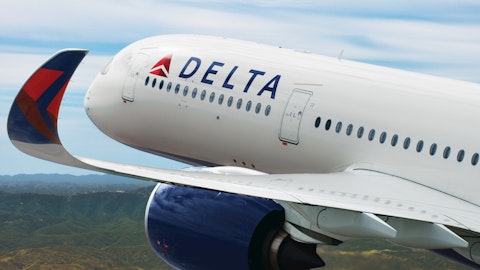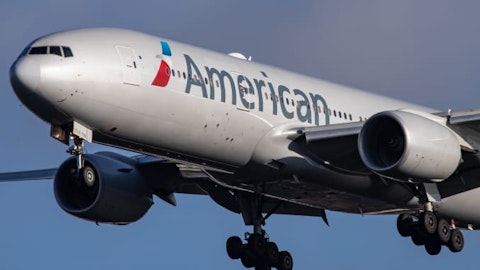And I think people want to keep the benefits rather than see them be passed to big box retailers who, could decide just to keep the profit for themselves. So I’ve got a great level of skepticism as to whether this would pass.
Daniel McKenzie: Okay, thanks for the time, you guys.
Operator: Your next question comes from Jamie Baker with JPMorgan. Please go ahead.
Jamie Baker: Oh hey, good morning, everybody. So obviously lots of talk about air traffic control, weather and oversupply and all that, but one thing that Mark and I have been thinking about is the remuneration from your credit card partners, from loyalties. So if we tie loyalty back to earnings, and if we think about your margins relative to just pick one, Delta or United, and I know Joanna talked about closing the gap, but do you have an internal estimate as to how many points of margin differential loyalty might currently be driving?
Robin Hayes: Yes hi, Jamie. Look it’s clearly a margin gap for us, right? I mean I think all these airlines report sort of roughly what their percentage of revenue is, and then if you assume that the margin on these programs are high, it’s definitely, it’s definitely single digit, low single digit percentages of difference. This is why actually, we’ve been so focused on not just building our travel, build our own loyalty program to sort of play catch up, but also creating JetBlue travel products. We know that we do not have the same exposure to business travel as some of these global leisure airlines, and so how do we gain more exposure, more share of wallet for leisure customers as well? And so our goal over time is to get to a point where our JetBlue travel products and our loyalty program together can be the point where they can compete for what I’d call a legacy airline type margin.
So that’s the road we’re on, Jamie. We’re not there yet, but we’re I think, making really good progress.
Jamie Baker: And thank you, Robin. And as a follow-up to that, you’ve talked about loyalty as a means to fund the business, particularly if you do find yourself, hypothetically, with greater leverage a year or so down the road. Spirit and Hawaiian Loyalty is now trading north of 20%. I guess, how are you thinking about loyalty as a funding option going forward? Do you need to identify some contingencies in terms of funding potential?
Robin Hayes: Hey, Jamie. I think we’re just going to kick that question to following the trial, not really addressing any of the Spirit-related questions today on the call.
Jamie Baker: Well, it had more to do with leverage than Spirit, but fair enough. Okay, thank you.
Operator: Your next question comes from Conor Cunningham with Melius Research. Please go ahead.
Conor Cunningham: Hi, everyone. Thank you. Could you speak a little bit to the puts and takes as you think about the cost structure in the 2024? It seems like maintenance is going to be up a fair bit. You have the flight attendant deal, but you also have some self-help initiatives. Just curious on how you’re thinking about it in the context of you’re talking about 1Q capacity being down your rear. It just seems like CASM ex is starting to track up year-over-year for 2024. Just curious on how you’re thinking about it now. Thank you.
Joanna Geraghty: Yes, thanks for the question, Connor. So maybe at the highest level, JetBlue typically is targeted mid to high single digit growth rate and then flat CASM ex-fuel. That profile is going to look different next year because of aircraft delivery delays. We have GTF aircraft that will be grounded, and also we’re continuing with the E190 retirement plan. And so the growth profile will look different. As you mentioned, capacity will be down in the first quarter, slightly down year-over-year, and we’re still working through our 2024 planning assumptions. You should assume that we will pinpoint CASM ex-fuel to be competitive compared to where we put, depending on where we put capacity. The headwinds, which we’ve always known about, is maintenance next year, just given the aging fleet, and also continued pressure on labor, right?
And just the inflationary environment, which is consistent with what others have been seeing. We obviously have another pilot step up in August of next year. So those are the headwinds, but those are really the reasons whereby which we put in place the structural cost program. And so the structural cost program is meant to offset some of these headwinds. So working through the planning process, you can expect us to have a competitive CASM ex-fuel number next year once we pinpoint capacity.
Conor Cunningham: Okay. Thank you. That’s helpful. And then on premium products, are you needing to discount those in the current environment? The reason why I ask is you’re seeing a sequential deceleration, versus 2019, from 3Q to 4Q, and I would have thought that maybe even more space would have protected you a little bit. Is that, I think you called out four points of RASM benefit from Mint. Is that continuing into 4Q? Just curious on how those products are specifically holding up. Thank you.
Joanna Geraghty: Yes. Thanks. This is Joanna. A great question. Yes. We are really pleased with how well premium continues to hold up, and we would expect those trends to continue into the fourth quarter. As we mentioned in the scripted remarks, as you look at next year, we’re actually taking all 321s in the Mint configuration, and the 220, 190 retirement will be going from 16 EMS seats to 30 EMS seats. So we’re very pleased with the strength that we are seeing in the premium sector moving forward.
Conor Cunningham: Okay. Thank you.
Operator: Your next question comes from Michael Lindenberg with Deutsche Bank. Please go ahead.
Shannon Doherty: Hi. Good morning. This is actually Shannon Doherty on for Mike. Just a quick one. We are hearing that the GTF engine inspection requirements are not based on aircraft manufacturer dates between mid-2015 and mid-2021, but rather the production and the timeline of the contaminated parts, which could be spilling into newer aircraft deliveries. Can you confirm this? And at this point, do you think that your A220s are going to be affected by this issue?
Ursula Hurley: Thanks for the question. So Pratt has given us an initial assessment of JetBlue’s exposure. So we highlighted on the call today we’ll have up to six aircraft grounded by the end of this year, and then that will increase as we navigate through next year. So we’ll end next year with high single digits, low double digit number of aircraft on the ground. So in regards to your specific serial number question, so on the PW1100, so that’s the A321 aircraft, a service bulletin is coming out imminently. And that’s important because it will give a very detailed view of serial numbers and it will solidify what we believe to be our exposure in 2024 and beyond. In regards to the 1500, the majority of our engines were manufactured post-2021.




